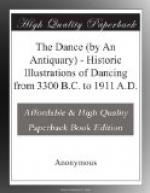[Illustration: Fig. 11.—The G[)e]r[)a]n[)o]s from a vase in the Museo Borbonico, Naples.]
[Illustration: Fig. 12.—Panathenaeac dance, about the 4th century B.C.]
[Illustration: Fig. 13.—A military dance, supposed to be the Corybantum. From a Greek bas-relief in the Vatican Museum.]
The G[)e]r[)a]n[)o]s, originally from Delos, is said to have been originated by Theseus in memory of his escape from the labyrinth of Crete (fig. 12). It was a hand-in-hand dance alternately of males and females. The dance was led by the representative of Theseus playing the lyre.
[Illustration: Fig. 14.—Greek dancer with castanets. (British Museum.) See also Castanet dance by Myron, fig. 63a.]
Of the second class, the gymnastic, the most important were military dances, the invention of which was attributed to Minerva; of these the Corybantum was the most remarkable. It was of Phrygian origin and of a mixed religious, military, and mimetic character; the performers were armed, and bounded about, springing and clashing their arms and shields to imitate the Corybantes endeavouring to stifle the cries of the infant Zeus, in Crete. The Pyrrhic (fig. 13), a war dance of Doric origin, was a rapid dance to the double flute, and made to resemble an action in battle; the Hoplites of Homer is thought to have been of this kind. The Dorians were very partial to this dance and considered their success in battle due to the celerity and training of the dance. In subsequent periods it was imitated by female dancers and as a pas seul. It was also performed in the Panathenaea by Ephebi at the expense of the Choragus, but this was probably only a mimetic performance and not warlike.
[Illustration: Fig. 15.—Cymbals (about 4 in.) and double flute. (British Museum.)]
There were many other heroic military dances in honour of Hercules, Theseus, etc.
The chorus, composed of singers and dancers, formed part of the drama, which included the recitation of some poetic composition, and included gesticulative and mimetic action as well as dancing and singing. The Dorians were especially fond of this; their poetry was generally choral, and the Doric forms were preserved by the Athenians in the choral compositions of their drama.
The tragic dance, Emmelia, was solemn; whilst that in comedy, Cordax, was frivolous, and the siccinis, or dance of Satyrs, was often obscene. They danced to the music of the pipes, the tambour, the harp, castanets, cymbals, etc. (figs. 14, 15, 16).
[Illustration: Fig. 16.—Greek dancers. From a vase in the Hamilton Collection.] [Illustration: Fig. 17.—Bacchanalian dancer. Vase from Nocera, Museum, Naples.]




